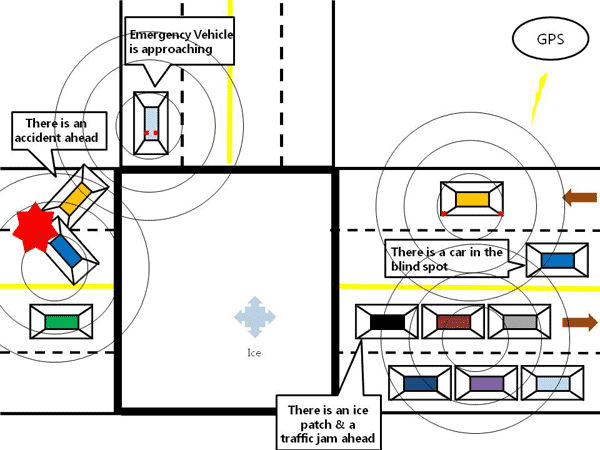Vehicle to Vehicle Communication Technology
by Sun Ko, Clemson Automotive Engineering Graduate Student
- Basic Description
-
Vehicle to vehicle (V2V) communication is a technology that allows communication among vehicles on the road. The primary benefit of V2V is to protect vehicles from potential road hazards and improve safety. V2V communication technology uses Dedicated Short Range Communications (DSRC), which in the US utilizes a 75-MHz bandwidth at a frequency of 5.9 GHz. It is designed to facilitate communication at distances of up to 1 km. The data exchanged may include a vehicle’s position, speed, throttle position, steering angle, brake status, turn signal status, number of people in the vehicle, etc.

V2V communication technology has great potential in vehicle safety applications. For example, if there is a car in the blind spot where the driver want to make a intended lane change, V2V communication alerts the driver based on the information received from the GPS to take corrective action. V2V communication also accumulates position and movement of surrounding vehicles and alerts the driver when a collision is likely to happen. If the driver fails to take action, the V2V system could automatically apply the brakes to stop the car. There are numerous other applications that could benefit from V2V communications. Some are:
- Intersection collision avoidance
- Pedestrian crash warning
- Road condition warning such as a traffic jam or an ice patch on the road
- Exchanging multimedia information.
According to the National Highway Traffic Safety Administration (NHTSA), 76% of car accidents could be prevented with the help of V2V communication technology. Since 2002, NHTSA has been conducting research on the development of V2V communication technology with automotive OEMs. The main obstacle for the technology to be deployed is that a large number of cars on the road must be equipped with the capability to transmit and receive the data in order for the technology to be effective. Also the communication protocol must be common among the vehicles. Numerous policy issues must be resolved as well before there will be wide-spread deployment of the technology. NHTSA is currently testing V2V communication technology in 6 different cities across the US and testing will continue through 2012. If it is proven that this technology works effectively to reduce crashes, then by 2013 their intention is to push automotive OEMs to agree to provide V2V communication technology in all new vehicles.
- Sensors
- GPS
- Actuators
- Brakes
- Data Communications
- DSRC
- For More Information
- [1] Vehicular Communication Systems, Wikipedia.
- [2] Honda Demonstrates V2V Communication System for Motorcyclists, gizmag.com, Oct. 22, 2008.
- [3] USDOT Connected Vehicle Research Program Vehicle-to-Vehicle Safety Application Research Plan, www.nhtsa.gov, October 2011. (pdf)
- [4] Ford V2V Collision Avoidance Demo, YouTube, June 22, 2011.
|

